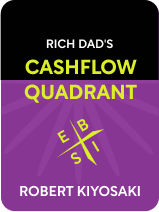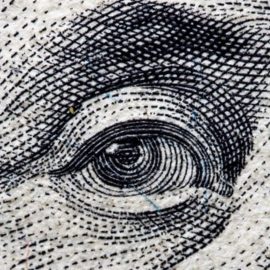

This article is an excerpt from the Shortform book guide to "Rich Dad's Cashflow Quadrant" by Robert T. Kiyosaki. Shortform has the world's best summaries and analyses of books you should be reading.
Like this article? Sign up for a free trial here .
What is Rich Dad’s Cashflow Quadrant about? What is the key message to take away from the book?
In Rich Dad’s Cashflow Quadrant, Robert Kiyosaki argues that to generate wealth, what kind of income you generate is more important than how much income you generate, or what kind of work you do. Kiyosaki uses the stories of his now-famous “Rich Dad” (his friend’s father) and “Poor Dad” (his own father) to illustrate how different income types lead to different results.
The following Rich Dad’s Cashflow Quadrant review covers the book’s context, background, and critical reception by the readers.
About the Author
Robert T. Kiyosaki was born in 1947 in Hawaii. He is a motivational speaker, real estate investor, and the author of the best-selling personal finance book of all time, Rich Dad Poor Dad. The book held a place on the New York Times Bestseller list for six years and has been translated into more than forty languages. Rich Dad’s Cashflow Quadrant is one of 14 books in the Rich Dad series, which together have sold over 26 million copies.
Before becoming a personal finance author and personality, Kiyosaki developed the educational board game CASHFLOW and founded his brand, The Rich Dad Company, with his wife, Kim Kiyosaki. In 2006 and 2011, Kiyosaki published books on personal finance and entrepreneurship with Donald Trump. Kiyosaki maintains a public presence and continues to make headlines, commenting on personal finance and politics.
Sharon Lechter co-wrote Rich Dad Poor Dad, Rich Dad’s Cashflow Quadrant, and most of Kiyosaki’s other books in the Rich Dad series. She’s an accountant and a businesswoman and was appointed to a position on the President’s Advisory Council on Financial Literacy in the Bush Administration. In the late 2010s, she sued Kiyosaki for cutting her out of her share of profit from their Rich Dad work and settled for $10 million.
Connect with Robert Kiyosaki:
The Book’s Publication and Context
Publisher: Warner Books
Rich Dad’s Cashflow Quadrant: Guide to Financial Freedom, published in 1998, is the sequel to Robert Kiyosaki’s 1997 blockbuster, Rich Dad Poor Dad. The Rich Dad Poor Dad series is part of a movement in popular personal finance books away from offering techniques for living below your means and saving as a strategy for building wealth. Instead, the Rich Dad books and others like it emphasize that to become rich, you need to learn to think like a rich person. Rich people, according to Kiyosaki, understand that the key to generating wealth is generating passive income.
Kiyosaki’s politics, which inform and appear in his books, range between libertarian and conservative. His anti-taxation, anti-entitlement, pro-gold standard positions shape his books, including Rich Dad’s Cashflow Quadrant.
The central principles in Rich Dad’s Cashflow Quadrant and Rich Dad, Poor Dad are the same: The best way to achieve wealth is to eschew prioritizing security and working hard at a “good job” in favor of cultivating boldness and learning to manage the risk of investing so you can create passive income. Rich Dad’s Cashflow Quadrant uses the idea of four income categories to make clear how the type of income you earn is central to generating wealth.
Critical Reception
The Rich Dad books have appealed to millions. Many readers credit the Rich Dad books with waking them up to the concept of passive income in the first place. Others appreciate Kiyosaki’s motivational persona, saying it inspired them to better manage their finances and learn about investing.
The books also have their fair share of critics, who are skeptical of the authenticity of Kiyosaki’s anecdotes and of the practicality of his advice. By Kiyosaki’s own admission, the books are less a step-by-step guide to achieving wealth than a readable, engaging rundown of the core concepts and values about money Kiyosaki says you need to rethink. The downside to that, and perhaps the most common critique of the Rich Dad series, is that the books can lack convincing supporting evidence. Rather than offering considered arguments for his advice, critics maintain that he relies on platitudes, political talking points, and unverifiable anecdotes.
Beyond insufficient evidence, some Rich Dad’s Cashflow Quadrant reviews criticized Kiyosaki for peddling controversial advice that can be dangerous for the novice entrepreneur or investor that the book targets. Among other contrarian claims, Kiyosaki argues that a 401(k) is a terrible investment and that your house is a liability, not an asset.
Much has also been made of Kiyosaki’s personal wealth. A common criticism of Kiyosaki (and other celebrity personal finance personalities) is that the bulk of his wealth comes not from his business investments, as he claims, but from his Rich Dad brand. Furthermore, commentators have long questioned whether the Rich Dad persona the brand revolves around is real; in 2003, Kiyosaki apparently admitted in a magazine interview that he didn’t see why “Rich Dad” had to be any more real than Harry Potter, though his books are clearly marketed as non-fiction.
Commentary on the Book’s Approach
Many reviewers consider the Rich Dad, Poor Dad books to be at least as much self-help as they are financial advice. Slate identifies the similarities the Rich Dad books, including Rich Dad’s Cashflow Quadrant, share with other popular self-help books, like Who Moved My Cheese and Fish:
- A disclaimer that the advice given isn’t a get-rich-quick scheme. (In a weight-loss book, for example, an author would claim that the book isn’t about getting skinny quick but rather a holistic approach to health.)
- An emphasis on the idea that the rich (or confident, or happy, or some other desirable category) have information that the rest of us don’t have.
- An emphasis on the idea that the path to wealth (replace “wealth” with anything else you might want to accomplish) lies in going against the grain in some way.
- Information delivered as general principles instead of highly specific actionables.
- And, of course, a memorable schtick.
Kiyosaki’s Rich and Poor Dads and their conflicting advice have indeed proved memorable and are often credited for the Rich Dad books’ enduring popularity. Kiyosaki’s personal anecdotes about his own life and those of his Rich and Poor Dads feature heavily in Rich Dad’s Cashflow Quadrant. While written in an engaging everyman style, Kiyosaki’s anecdotes can be more entertaining than instructive: He often fashions his personal anecdotes as parables, though the average person would have an exceedingly hard time replicating his circumstances.

———End of Preview———
Like what you just read? Read the rest of the world's best book summary and analysis of Robert T. Kiyosaki's "Rich Dad's Cashflow Quadrant" at Shortform .
Here's what you'll find in our full Rich Dad's Cashflow Quadrant summary :
- Why the traditional path of college to career doesn't work
- Which types of income will lead you to financial freedom
- An in-depth look at Robert Kiyosaki's four cashflow quadrants






